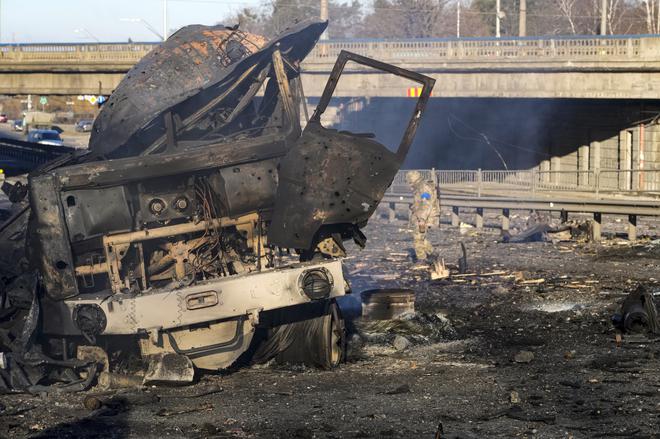Context
-
Russia has been accused of using deadly vacuum bombs, also called thermobaric bombs or fuel-air explosives, during its ongoing invasion of neighbouring country Ukraine.
What is a vacuum bomb?
- A vacuum bomb is an advanced weapon of destruction that is capable of destroying reinforced buildings and vaporising human bodies within its area of impact.

Photo Credit: AP - The bomb consists of a fuel container and two separate explosive charges.
- When a vacuum bomb hits the target,
- The first charge ignites the container and disperses the fuel that mixes with oxygen in the air.
- The second charge detonates this fuel cloud, causing shockwaves and high-temperature explosion.
- The detonation of the cloud creates a massive fireball, sucking all the oxygen in the blast radius.
- The fuel cloud can penetrate unsealed or poorly-sealed buildings, making the bomb far more dangerous than conventional weapons.
- A vacuum bomb can be launched as a rocket or dropped from an aircraft.
- Russia’s TOS-1 heavy flamethrower that shoots thermobaric rockets was spotted south of Belgorod.
- Belgorod is a Russian city situated near the Ukraine border and it is believed that the flamethrower was being deployed to be used in the ongoing invasion.
Are there any past instances of the use of vacuum bombs?
- The first reported use of vacuum bombs dates back to the Second World War when it was initially used by the German Army.
- Russia tested its powerful “Father of All Bombs”, officially the Aviation Thermobaric Bomb of Increased Power, in 2007. The vacuum bomb is equivalent to 44 tonnes of T.N.T. According to the Russian military, it is the mightiest bomb to be ever created.
Source: TH
Visit Abhiyan PEDIA (One of the Most Followed / Recommended) for UPSC Revisions: Click Here
IAS Abhiyan is now on Telegram: Click on the Below link to Join our Channels to stay Updated
IAS Abhiyan Official: Click Here to Join
For UPSC Mains Value Edition (Facts, Quotes, Best Practices, Case Studies): Click Here to Join
